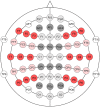Take a stand on understanding: electrophysiological evidence for stem access in German complex verbs
- PMID: 25767442
- PMCID: PMC4341544
- DOI: 10.3389/fnhum.2015.00062
Take a stand on understanding: electrophysiological evidence for stem access in German complex verbs
Abstract
The lexical representation of complex words in Indo-European languages is generally assumed to depend on semantic compositionality. This study investigated whether semantically compositional and noncompositional derivations are accessed via their constituent units or as whole words. In an overt visual priming experiment (300 ms stimulus onset asynchrony, SOA), event-related potentials (ERPs) were recorded for verbs (e.g., ziehen, "pull") that were preceded by purely semantically related verbs (e.g., zerren, "drag"), by morphologically related and semantically compositional verbs (e.g., zuziehen, "pull together"), by morphologically related and semantically noncompositional verbs (e.g., erziehen, "educate"), by orthographically similar verbs (e.g., zielen, "aim"), or by unrelated verbs (e.g., tarnen, "mask"). Compared to the unrelated condition, which evoked an N400 effect with the largest amplitude at centro-parietal recording sites, the N400 was reduced in all other conditions. The rank order of N400 amplitudes turned out as follows: morphologically related and semantically compositional ≈ morphologically related and semantically noncompositional < purely semantically related < orthographically similar < unrelated. Surprisingly, morphologically related primes produced similar N400 modulations-irrespective of their semantic compositionality. The control conditions with orthographic similarity confirmed that these morphological effects were not the result of a simple form overlap between primes and targets. Our findings suggest that the lexical representation of German complex verbs refers to their base form, regardless of meaning compositionality. Theories of the lexical representation of German words need to incorporate this aspect of language processing in German.
Keywords: complex verbs; derivational morphology; event-related potentials; form priming; morphological priming; semantic priming; stem access.
Figures







References
-
- Baayen H. R., Piepenbrock R., van Rijn H. (1993). The CELEX Lexical Database (on CD-ROM). Philadelphia, PA: Linguistic Data Consortium, University of Pennsylvania.
-
- Crepaldi D., Rastle K., Coltheart M., Nickels L. (2010). ‘Fell’primes ‘fall’, but does ‘bell’prime ‘ball’? Masked priming with irregularly-inflected primes. J. Mem. Lang. 63, 83–99 10.1016/j.jml.2010.03.002 - DOI
LinkOut - more resources
Full Text Sources
Other Literature Sources
Research Materials

